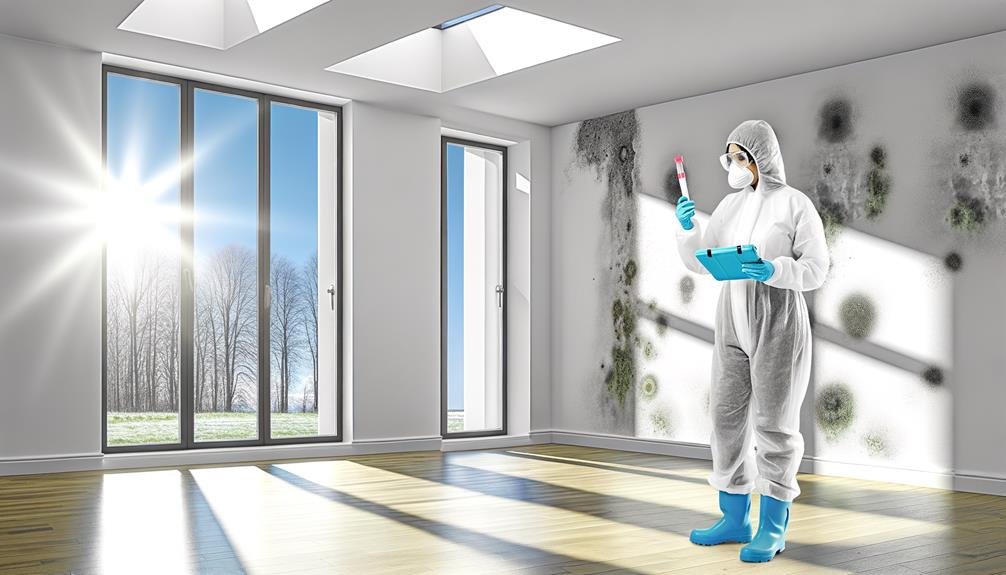In Atlanta, mold remediation is essential for protecting your health and home. Professional services effectively identify hidden mold sources and utilize specialized equipment for thorough removal. You'll benefit from techniques like HEPA filtration and antimicrobial treatments, ensuring air quality remains safe during the process. Handling mold yourself can be risky, as DIY methods often miss vital factors. With expert guidance, you can expect a safer, mold-free environment that reduces health risks associated with mold exposure. If you're interested in understanding more about specific techniques and strategies, further exploration will provide valuable insights.
Understanding Mold Growth
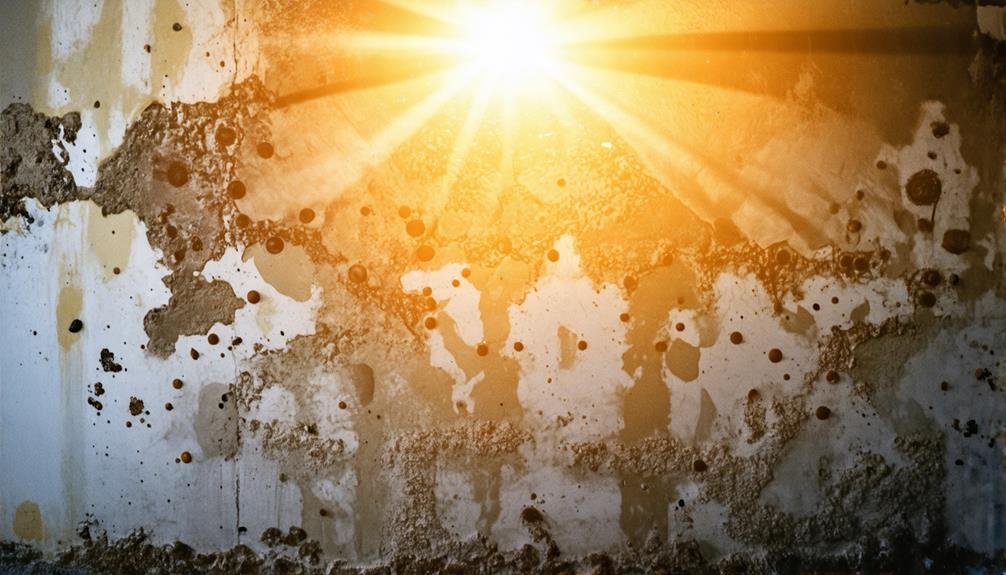
Mold growth occurs when spores, which are present in the air, find a damp environment with organic material to thrive on, leading to potential health risks and structural damage. Understanding the mold lifecycle stages is fundamental for effective remediation. It starts with the spore stage, where microscopic spores remain dormant until they encounter ideal conditions—specifically moisture, warmth, and a food source.
Once these conditions are met, the spores germinate and enter the mycelial stage, where they develop into a network of hyphae. These hyphae can penetrate surfaces, breaking down organic matter. Environmental factors play a significant role in this process; high humidity levels, temperature variations, and inadequate ventilation can all accelerate mold proliferation.
As the mold matures, it produces more spores, which disperse into the air, perpetuating the cycle. You need to address these environmental factors promptly to prevent the mold from advancing to the reproductive stage. Regular inspections and moisture control are critical for maintaining a mold-free environment. By understanding this lifecycle and its triggers, you can take proactive measures to safeguard your space against mold growth.
Health Risks of Mold
Exposure to mold can lead to a variety of health issues, particularly for individuals with respiratory conditions, allergies, or weakened immune systems. When you inhale mold spores, they can trigger mold allergies, resulting in symptoms like sneezing, runny nose, and itchy eyes. These reactions can intensify quickly, especially if you're sensitive to specific mold types.
For those with pre-existing respiratory issues, such as asthma or chronic obstructive pulmonary disease (COPD), exposure can worsen symptoms, leading to increased wheezing, coughing, and difficulty breathing. Mold can additionally release mycotoxins, which, when inhaled or ingested, may cause more severe health problems, such as lung infections or systemic illness.
Even healthy individuals aren't immune. Prolonged exposure can lead to respiratory issues that manifest as chronic sinusitis or other complications. It's essential to recognize that the risk isn't just immediate; long-term exposure can contribute to ongoing health problems, diminishing your quality of life.
If you suspect mold in your environment, taking immediate action is critical. Prioritizing your health means addressing mold issues before they escalate into serious health concerns.
Signs of Mold Infestation
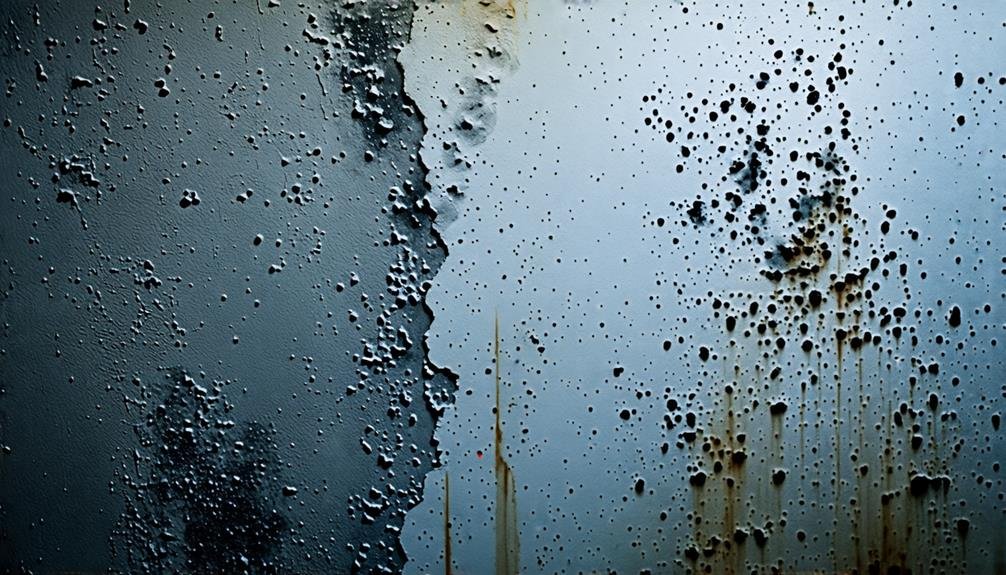
When evaluating your space for mold infestation, look for visible mold growth on surfaces, which can appear as black, green, or white spots. Furthermore, if you notice a persistent musty odor, it often indicates hidden mold presence. Recognizing these signs early can prevent more extensive damage and health risks.
Visible Mold Growth
Identifying visible mold growth is vital for early intervention and preventing further damage to your property. When you spot mold, it's important to recognize its potential impact and take action promptly. Different mold types can thrive in various conditions, often because of moisture control issues. Here are three key signs to watch for:
- Color Variations: Mold can appear in numerous colors, including black, green, white, or even orange. Each color may indicate different mold types, each with unique risks to your health and property.
- Surface Texture: You might notice a fuzzy or slimy texture on surfaces. This indicates active mold growth and should be addressed immediately to avoid spreading.
- Location: Mold commonly grows in damp areas, like bathrooms, basements, or around windows. If you see discoloration in these spots, it's a clear signal that moisture control measures are necessary to prevent further infestation.
Musty Odor Presence
A musty odor often signals the presence of mold, indicating that moisture problems may be contributing to an infestation within your home. Identifying musty odor sources is vital for addressing mold issues effectively. Common sources include damp basements, leaky pipes, or areas with inadequate ventilation. If you notice a persistent musty smell, it's important to investigate these areas thoroughly, as they can harbor mold growth hidden behind walls or under flooring.
To tackle the musty odor, you'll want to implement musty odor solutions that not only eliminate the smell but additionally address the underlying moisture issue. Start by fixing any leaks or water intrusion problems, ensuring your home stays dry. Improving ventilation in high-humidity areas like bathrooms or kitchens can likewise help reduce moisture buildup.
Once the moisture is under control, consider using air purifiers with HEPA filters to capture mold spores and improve air quality. If the odor persists, professional mold remediation services can identify and remove mold colonies safely, ensuring your home remains mold-free. By understanding the relationship between musty odors and mold, you can take proactive steps to maintain a healthier living environment.
The Importance of Professional Help
Hiring professionals for mold remediation guarantees that the problem is addressed thoroughly, reducing the risk of recurrence and protecting your health. Many homeowners fall for mold remediation myths, believing that DIY solutions are sufficient. Nevertheless, this approach often overlooks critical factors. Here's why you should seek professional help:
- Expertise in Identifying Sources: Professionals have the training and experience to locate hidden mold sources that you might miss, assuring an all-encompassing removal.
- Effective Remediation Techniques: They utilize specialized equipment and techniques, such as HEPA filtration and antimicrobial treatments, to eliminate mold effectively and prevent regrowth.
- Health Risk Management: Mold can pose serious health risks, particularly to sensitive individuals. Professionals follow safety protocols to minimize exposure during the remediation process.
Choosing professional vs. DIY methods can make a significant difference in the outcome of your mold issue. While DIY might seem appealing, the potential hazards and incomplete remediation can lead to more significant problems down the line. Invest in professional help to guarantee your home stays healthy and mold-free.
Mold Inspection Process
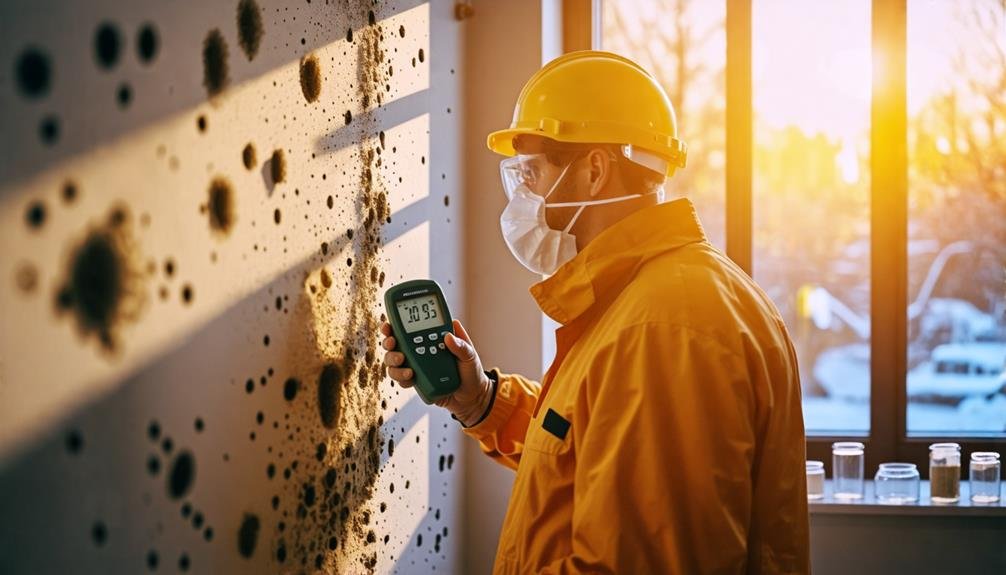
The mold inspection process involves a systematic assessment of your property to detect visible mold growth and identify potential moisture sources that could lead to future infestations. To guarantee a thorough inspection, professionals utilize various inspection tools such as moisture meters, thermal imaging cameras, and air sampling devices. These tools help pinpoint hidden mold and moisture issues that may not be immediately apparent.
Here's a breakdown of the mold inspection process:
| Step | Description | Tools Used |
|---|---|---|
| Initial Assessment | Walkthrough to visually identify mold | Visual inspection tools |
| Moisture Measurement | Checking humidity levels | Moisture meters |
| Air Sampling | Testing air quality for spores | Air sampling devices |
| Surface Sampling | Collecting samples from surfaces | Swab or tape lifts |
| Report Generation | Documenting findings and recommendations | Reporting software |
After the inspection, mold testing results guide the remediation plan. By understanding the severity and location of mold issues, you gain the freedom to make well-informed choices about your property's health and safety. Don't underestimate the importance of this step in guaranteeing a mold-free environment.
Mold Removal Techniques
When you're tackling mold removal, it's essential to employ safe removal methods to protect both yourself and your environment. You'll likewise want to implement preventive measures to guarantee mold doesn't return after you've completed the removal process. Understanding these techniques can greatly improve your mold remediation efforts.
Safe Removal Methods
Safe removal methods for mold involve employing techniques that assure both effective eradication and minimal risk to your health and environment. By utilizing eco-friendly solutions and advanced technologies, you can guarantee a thorough and safe mold remediation process. Here are three key methods to reflect on:
- HEPA Filtration: High-Efficiency Particulate Air (HEPA) filters capture 99.97% of airborne mold spores, preventing them from spreading during the removal process. This advanced technology helps maintain air quality.
- Chemical-Free Cleaning Agents: Opt for eco-friendly solutions that utilize natural ingredients. These agents effectively kill mold without introducing harmful chemicals into your living space, keeping the environment safe.
- Controlled Containment: Using plastic barriers and negative air pressure systems, you can isolate the contaminated area. This method prevents spores from dispersing throughout your home, assuring a localized and safe removal.
Implementing these techniques allows you to tackle mold effectively while safeguarding your health and the environment. By choosing safe removal methods, you're not just eradicating mold; you're creating a healthier living space for you and your loved ones.
Preventive Measures Implemented
Implementing preventive measures is vital in minimizing the risk of mold growth after remediation, guaranteeing that your living environment remains healthy and mold-free. One effective strategy is the use of mold-resistant materials in construction or renovation. These materials are specifically designed to inhibit mold growth, making them ideal for areas prone to moisture, such as bathrooms and basements.
Furthermore, controlling humidity is critical. Keep indoor humidity levels below 60% by using dehumidifiers or air conditioning systems. Regularly ventilate your home, especially in areas prone to moisture, to promote airflow. Verify that exhaust fans are functioning properly in high-humidity zones like kitchens and bathrooms.
In addition, inspect your plumbing and roofing for leaks regularly. Promptly addressing any water intrusion can greatly reduce the likelihood of mold development. Using vapor barriers in crawl spaces can likewise prevent moisture accumulation.
Preventative Measures
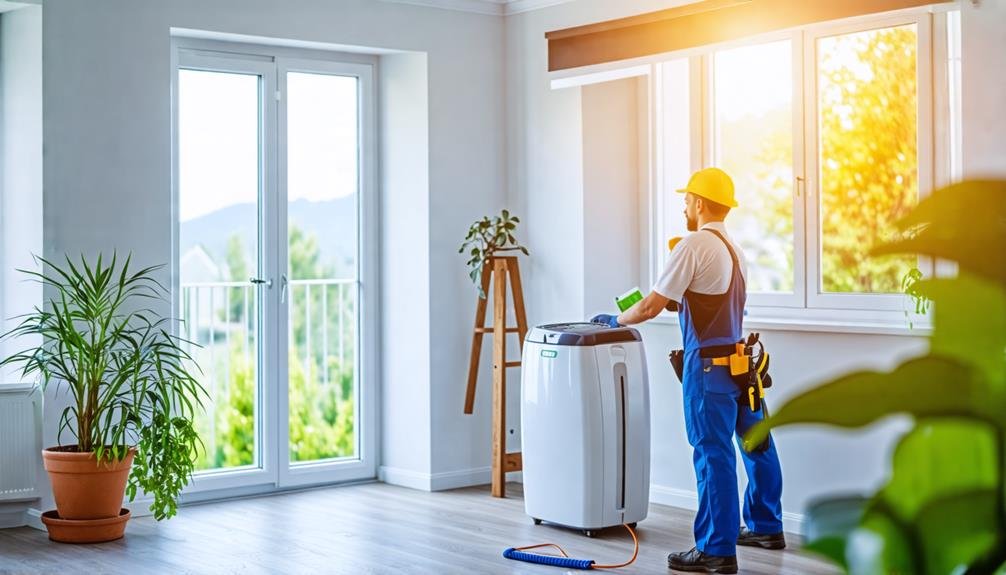
Regularly monitoring humidity levels in your home is crucial to preventing mold growth, as maintaining a relative humidity below 50% creates an inhospitable environment for spores. Effective humidity control and proper air circulation are your best defenses against mold proliferation. Here are three key preventative measures you can implement:
- Use Dehumidifiers: Invest in a quality dehumidifier, especially in damp areas like basements and bathrooms. This device will help you maintain ideal humidity levels.
- Improve Ventilation: Confirm your home has adequate air circulation. Open windows when weather permits, and use exhaust fans in bathrooms and kitchens to disperse moisture-laden air.
- Seal Leaks: Regularly inspect your home for leaks in roofs, walls, and plumbing. Promptly repair any issues to prevent moisture accumulation, as even small leaks can create a perfect breeding ground for mold.
Choosing a Remediation Service
When you're selecting a mold remediation service, it's essential to take into account their credentials and certifications to guarantee compliance with industry standards. Evaluating their experience and expertise will give you confidence in their ability to tackle your specific mold issues effectively. Finally, review their service offerings to make certain they meet your unique needs and address the extent of the mold problem in your environment.
Credentials and Certifications
To guarantee effective mold remediation, it's vital to verify the credentials and certifications of the service you choose, as these indicators reflect the company's expertise and adherence to industry standards. Understanding the certification importance can empower you to make knowledgeable choices about the safety and health of your environment.
When evaluating a remediation service, focus on these key aspects of credential verification:
- Industry Certifications: Look for certifications from recognized bodies like the Institute of Inspection, Cleaning and Restoration Certification (IICRC) or the National Organization of Remediators and Mold Inspectors (NORMI). These signify that the company follows established protocols.
- Insurance Coverage: Ascertain the company carries liability insurance and worker's compensation. This protects you from potential liabilities during the remediation process.
- Training and Education: Inquire about the training programs the technicians have completed. Continuing education in mold remediation techniques is vital for staying current with best practices.
Experience and Expertise
Experience and expertise are vital factors to take into account when selecting a mold remediation service, as they directly influence the effectiveness and safety of the remediation process. When you're facing mold issues, it's imperative to choose a team that understands various mold remediation techniques and can tailor their approach to your specific situation.
Here's a quick overview of what to look for:
| Criteria | Importance |
|---|---|
| Years of Experience | A long history indicates reliability and skill. |
| Knowledge of Techniques | Familiarity with the latest methods guarantees effective remediation. |
| Availability of Expert Consultation | Access to specialists can provide tailored solutions and advice. |
Service Offerings Evaluation
Evaluating the service offerings of a mold remediation company is vital for guaranteeing that you receive thorough and effective solutions tailored to your specific mold issue. When choosing the right service, you should focus on several key factors to make a well-informed choice.
- Comprehensive Assessment: Look for companies that perform a detailed evaluation of your property to identify the extent of mold growth and the type of mold present. This guarantees targeted remediation strategies.
- Advanced Techniques: Verify that the company employs state-of-the-art technology and methods, such as HEPA filtration and thermal imaging, to effectively eliminate mold and prevent future growth.
- Customer Testimonials: Always check customer testimonials and reviews. Feedback from past clients can provide insights into the company's reliability, quality of service, and responsiveness.
Conducting a service comparison can help you weigh these factors against each other. By focusing on these elements, you'll empower yourself to choose a mold remediation service that not only addresses your specific needs but also guarantees your home remains a safe and healthy environment.
Cost of Mold Remediation
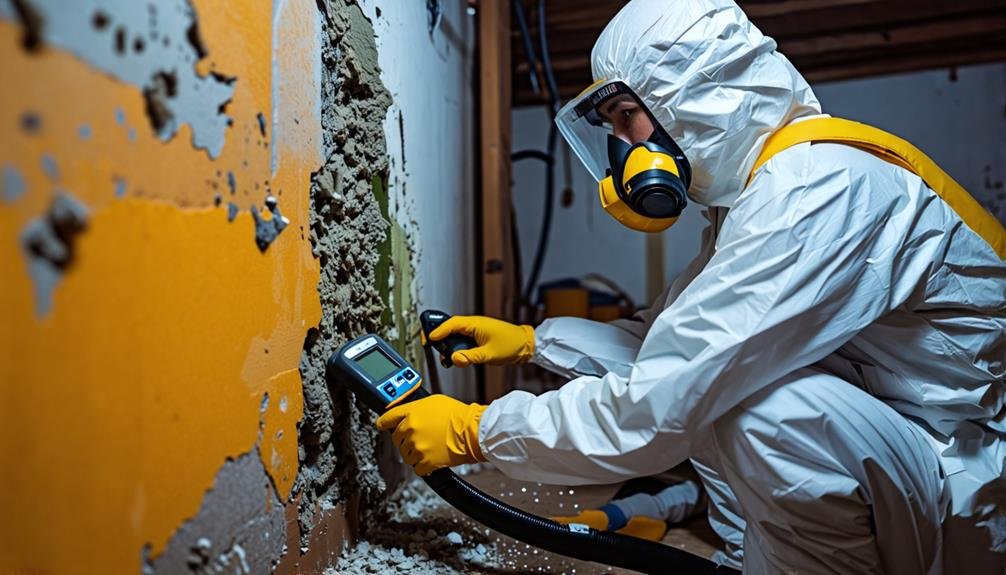
Understanding the cost of mold remediation involves considering various factors, including the extent of the infestation, the type of materials affected, and the necessary remediation methods. On average, you can expect costs to range from $500 to $6,000, depending on the severity of the problem. Minor issues might only require a few hundred dollars, while extensive infestations that require significant repairs could push the price into the thousands.
Insurance coverage can also play an essential role in determining your out-of-pocket expenses. Many homeowners' insurance policies cover mold remediation, but it typically depends on the cause of the mold and your specific policy terms. For instance, if the mold resulted from a sudden leak, you might find coverage more accessible. Nevertheless, mold stemming from long-term neglect may not be covered.
Additionally, location and the expertise of the remediation company can influence costs. Companies with advanced equipment or specialized training may charge higher rates but often guarantee a thorough job. To make a well-informed choice, always request detailed quotes and assess your insurance options before proceeding with remediation. Your goal is to guarantee a safe, mold-free environment without overspending.
Maintaining a Mold-Free Home
After addressing the financial implications of mold remediation, it's vital to implement proactive measures that guarantee your home remains free of mold. By adopting effective mold prevention strategies, you improve your indoor air quality and secure a healthier living environment.
- Control Humidity Levels: Maintain indoor humidity below 50% using dehumidifiers and proper ventilation. Regularly check basements, bathrooms, and kitchens, as these areas are prone to dampness.
- Guarantee Proper Ventilation: Use exhaust fans in high-moisture areas, like kitchens and bathrooms. Open windows whenever possible to improve air circulation, which helps reduce moisture buildup.
- Regular Inspections: Periodically inspect your home for leaks or water damage. Address any plumbing issues promptly and keep an eye out for signs of mold, such as discoloration or musty odors.
Implementing these strategies not only prevents mold growth but also greatly improves your indoor air quality. By taking these steps, you can enjoy a mold-free home and the peace of mind that comes with it. Freedom from mold is achievable; it just takes a little diligence and commitment.
Conclusion
In the battle against unwanted spores, embracing professional mold remediation services is your best defense. With their expertise, you can reclaim your space from the shadows of mold, ensuring a healthier environment for you and your loved ones. Remember, prevention is key; by taking proactive measures, you can shield your home from future infestations. So, breathe easy and let the experts guide you in maintaining a sanctuary, free from the hidden dangers of mold lurking in the corners.

